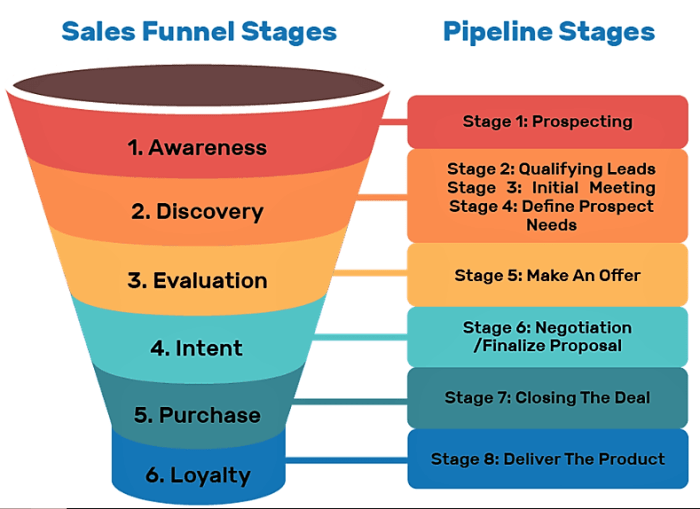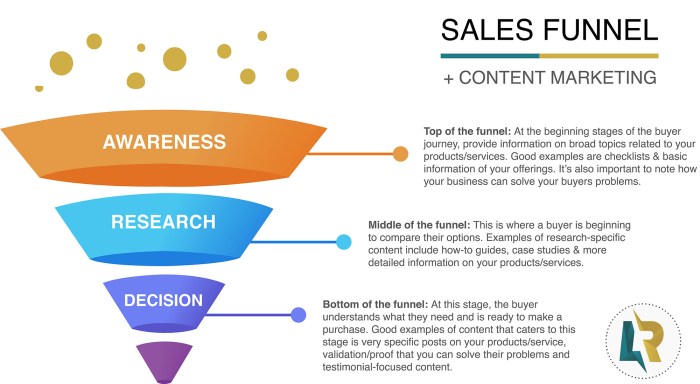Developing a Sales Funnel Content Plan kicks off with a bang, offering an inside look at crafting content that drives sales. Dive in for a hip, high school-style journey through the world of marketing magic!
Get ready to explore the ins and outs of creating a killer content plan that will have your audience hooked from start to finish.
Understanding Sales Funnels
In the world of marketing, a sales funnel is a vital tool that helps businesses guide potential customers through the buying process. It is a step-by-step journey that customers go through before making a purchase, starting from awareness to conversion. Understanding sales funnels is crucial for businesses to effectively convert leads into loyal customers.
Importance of Sales Funnels
Sales funnels play a key role in marketing strategies by providing a structured approach to lead nurturing and customer conversion. By breaking down the customer journey into stages, businesses can tailor their marketing efforts to address the specific needs and concerns of potential customers at each stage. This personalized approach enhances customer engagement and increases the likelihood of conversion.
- Awareness: This is the initial stage where potential customers become aware of a product or service through marketing efforts such as ads, social media, or content.
- Interest: In this stage, customers show interest in the product or service and seek more information to evaluate its value and benefits.
- Decision: Customers reach the decision stage where they are ready to make a purchase but may compare options, read reviews, or seek discounts before committing.
- Action: The final stage is where customers take action and make a purchase, becoming loyal customers if satisfied with their experience.
Sales funnels help in converting leads into customers by guiding them through a structured journey that addresses their needs and concerns at each stage of the buying process.
Creating a Content Plan
Developing a sales funnel content plan involves several key steps to ensure a strategic approach to engaging potential customers at every stage of the buyer’s journey. By aligning content with the specific needs and interests of your target audience, you can effectively guide them through the sales funnel towards a conversion.
Identify Target Audience
To begin creating a content plan, it’s essential to clearly define your target audience. Understand their demographics, preferences, pain points, and motivations to tailor your content to resonate with them effectively.
Define Funnel Stages
Identify the different stages of your sales funnel, such as awareness, consideration, and decision. Each stage requires specific types of content to move prospects closer to making a purchase.
Content Types for Each Funnel Stage
- Awareness Stage: At this stage, focus on creating educational and informative content to attract prospects and build brand awareness. Examples include blog posts, infographics, and social media posts.
- Consideration Stage: Provide more in-depth content that addresses the needs and pain points of your audience. Consider webinars, case studies, and product demos to showcase your expertise.
- Decision Stage: Offer content that helps prospects make a buying decision, such as free trials, testimonials, and comparison guides.
Aligning Content with Buyer’s Journey
To align content with the buyer’s journey, map out the different touchpoints where prospects interact with your brand. Tailor content for each touchpoint to guide them seamlessly through the funnel. By understanding the buyer’s mindset at each stage, you can create content that addresses their specific needs and concerns, ultimately leading to a successful conversion.
Target Audience Research: Developing A Sales Funnel Content Plan

In order to create a successful sales funnel content plan, it is crucial to conduct thorough target audience research. By understanding the needs, preferences, and behaviors of your target audience, you can tailor your content to effectively engage and convert potential customers.
Importance of Target Audience Research
Target audience research is essential for a sales funnel content plan as it allows you to identify the specific demographics, interests, and pain points of your ideal customers. This information helps you create content that resonates with your audience, ultimately leading to higher conversion rates and increased sales.
- Utilize surveys, interviews, and data analytics to gather information about your target audience.
- Study competitors and industry trends to gain insights into what is resonating with similar audiences.
- Segment your audience based on factors such as age, location, interests, and purchasing behavior to create targeted content.
Tailoring Content to Different Audience Segments
Once you have identified different audience segments within your sales funnel, it is important to tailor your content to meet their specific needs and preferences. By personalizing your messaging and offers, you can effectively move leads through the funnel towards making a purchase.
- Develop targeted content for each stage of the funnel, addressing the unique concerns and motivations of prospects at each level.
- Use language and imagery that resonates with each audience segment, creating a sense of connection and understanding.
- Test different approaches and messaging to see what resonates best with each audience segment, optimizing your content for maximum impact.
Content Creation Strategies

When it comes to creating content for your sales funnel, it’s crucial to engage your audience at every stage of their journey. Here are some strategies to help you create compelling content that drives conversions:
Role of Storytelling in Content Creation
Storytelling plays a vital role in creating an emotional connection with your audience. By weaving narratives into your content, you can capture their attention and build trust. Use real-life examples, customer testimonials, or case studies to make your content more relatable and impactful.
Tips for Maintaining Consistency
- Define your brand voice and tone: Consistency in messaging starts with establishing a clear brand voice that resonates with your target audience. Whether you’re aiming for a casual, friendly tone or a professional demeanor, stick to it throughout your content.
- Create a content style guide: Document your brand’s guidelines for content creation, including preferred language, formatting, and visual elements. This ensures that all your content aligns with your brand identity.
- Use templates and frameworks: Develop templates for different types of content, such as blog posts, emails, or social media updates. This streamlines the content creation process and helps maintain consistency in messaging.
- Monitor performance and feedback: Regularly track the performance of your content and gather feedback from your audience. Use this data to refine your content strategy and ensure that your messaging remains relevant and engaging.
Measuring Success
In the world of sales funnels, measuring success is crucial to understanding the effectiveness of your content plan. By tracking key performance indicators (KPIs) and analyzing data, you can optimize your strategy for better results.
Key Performance Indicators (KPIs), Developing a Sales Funnel Content Plan
- Conversion Rate: Measure the percentage of visitors who take the desired action at each stage of the funnel.
- Customer Acquisition Cost (CAC): Calculate the cost of acquiring a new customer, including marketing and sales expenses.
- Customer Lifetime Value (CLV): Determine the total revenue a customer is expected to generate over their lifetime.
- Retention Rate: Measure the percentage of customers who continue to engage with your brand over time.
Tools and Methods for Measurement
- Google Analytics: Track website traffic, conversions, and user behavior to assess the performance of your sales funnel.
- Email Marketing Platforms: Monitor open rates, click-through rates, and conversion rates to evaluate the effectiveness of email campaigns.
- CRM Systems: Use customer relationship management tools to analyze customer interactions and track progress through the funnel.
Analyzing Data for Optimization
- Identify Bottlenecks: Pinpoint areas of the funnel where visitors are dropping off or not progressing to the next stage.
- A/B Testing: Experiment with different content variations to determine which performs best and drives higher conversions.
- Iterative Improvements: Continuously analyze data, make adjustments to your content plan, and test new strategies to optimize results.












